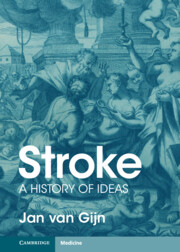Book contents
- Stroke
- Stroke
- Copyright page
- Epigraph
- Dedication
- Contents
- Preface
- One The Ventricles
- Two The Force of Blood
- Three Congestion
- Four Forgotten Forms of Apoplexy
- Five Haemorrhage
- Six Ramollissement
- Seven Thrombosis and Embolism
- Eight No Man’s Land: The Neck Arteries
- Nine Lacunes
- Ten Stroke Warnings
- Eleven Saccular Aneurysms
- Twelve Cerebral Venous Thrombosis
- Epilogue
- Acknowledgements
- References
- Index
One - The Ventricles
Apoplexy in the Sixteenth Century
Published online by Cambridge University Press: 06 July 2023
- Stroke
- Stroke
- Copyright page
- Epigraph
- Dedication
- Contents
- Preface
- One The Ventricles
- Two The Force of Blood
- Three Congestion
- Four Forgotten Forms of Apoplexy
- Five Haemorrhage
- Six Ramollissement
- Seven Thrombosis and Embolism
- Eight No Man’s Land: The Neck Arteries
- Nine Lacunes
- Ten Stroke Warnings
- Eleven Saccular Aneurysms
- Twelve Cerebral Venous Thrombosis
- Epilogue
- Acknowledgements
- References
- Index
Summary
Hippocratic and Galenic texts, fully rediscovered in the first half of the sixteenth century, defined apoplexy as a sudden collapse, with loss of movement and sensation, except for preserved heart action and respiration. Though this definition leaves room for divergent interpretations, early physicians who made the diagnosis rarely specified the symptoms.
Information
- Type
- Chapter
- Information
- StrokeA History of Ideas, pp. 1 - 36Publisher: Cambridge University PressPrint publication year: 2023
